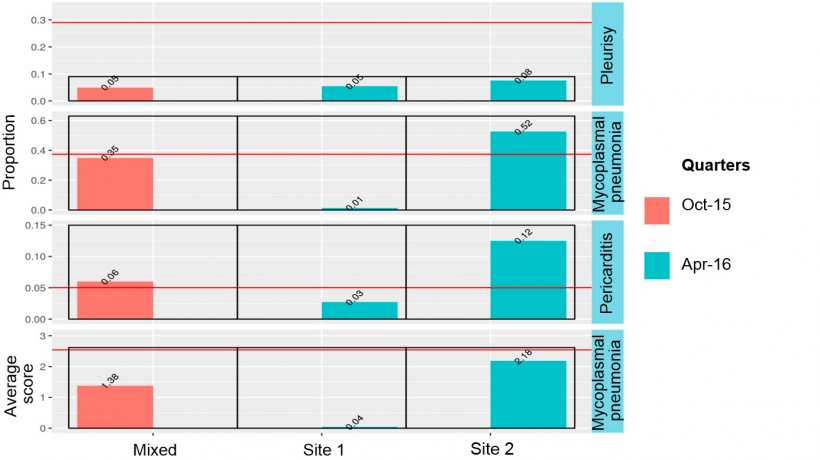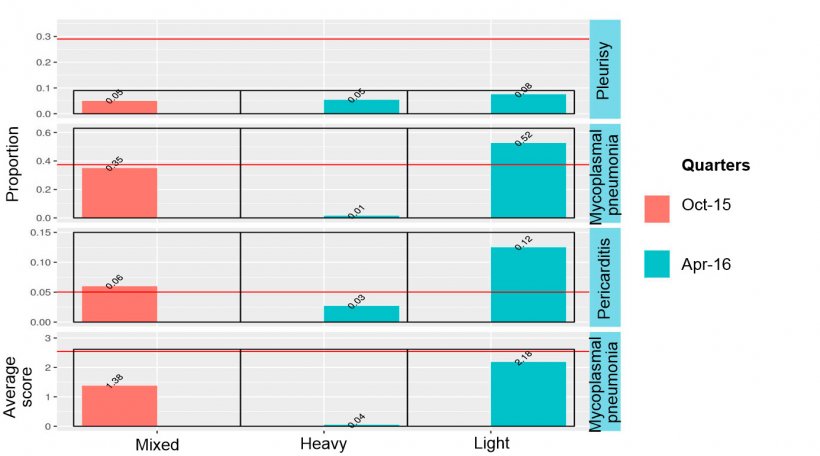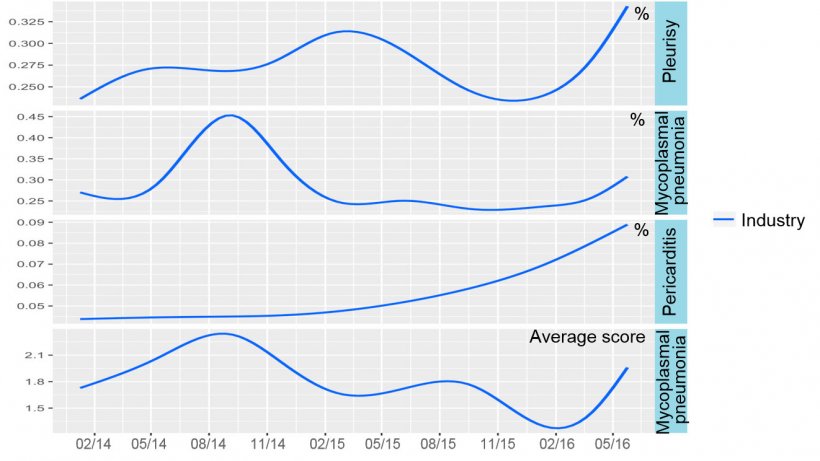Introduction
This case report charts the trends in abattoir lesions from October 2014 to April 2016 in a 280 sow herd in Ireland. During this period, notable differences in the level of pathological lesions were noted in association with contrasting Mycoplasma hyopneumoniae (M hyo) vaccination regimes and different production systems.

Production system
The farm consists of two production sites. The breeding herd is located at site 2. Both weaner and finisher accommodation are present on sites 1 and 2. Approximately 160 pigs are weaned each week at an average age of 28 days. 50% of the weaned pigs are moved to weaner housing at the breeding site (site 2), while the other 50% are transferred off site to weaner accommodation and subsequently to finisher accommodation at site 1. At the breeding site, pigs are transferred to finisher accommodation off site (site 1) eight weeks out of 10, at the end of the weaner production cycle. Two weeks out of 10, they are moved to finisher housing at the breeding farm (site 2).
The two site production system layout and pig flow are illustrated in Figure 1.

Health status
The herd is infected with M. hyo, PRRS, PCV2 and swine influenza.
Health plan: hygiene, vaccination and medication protocols
First stage weaner houses are washed and disinfected between batches. Second stage weaner and finisher houses are washed but not disinfected between batches.
Piglets are vaccinated against M. hyo (single dose until December 2014 and two doses after December 2014), PRRS and PCV2.
Creep feed provided for the first 7-14 days post weaning contains Amoxicillin and zinc oxide. Link feed contains zinc oxide. Weaner and finisher feeds are not medicated.
The hygiene, vaccination and medication programmes in place during 2015-2016 are described in Table 1.
Table 1: Hygiene, Vaccination and Medication Programmes 2015-2016.
| SITE 2 Sows+P+W+F | SITE 1 W+F | |
| Weaning age | 28 days | |
| Hygiene | ||
| W1 | Wash/Disinfect | |
| W2/Finisher | Wash | |
| Vaccination regime | Mycoplasma (7+28 days) | |
| PRRS (14 days) | ||
| PCV2 (28 days) | ||
| Feed medication | ||
| Creep | Amoxicillin, ZnO | |
| Link | ZnO | |
Abattoir surveillance 2014-2015
An AIMS (Agrihealth Inspection and Monitoring Service) health check was carried out at the abattoir in October 2014, in response to an increase in the level of respiratory disease observed on the farm. The proportion of pigs examined with Mycoplasmal pneumonia lesions (50%) and the average score (Goodwin method) per pig (4.3) was high. The involvement of M. hyo was confirmed by histopathology testing of formalin fixed lung lesions. Pleurisy prevalence was low.
The M. hyo vaccination regime was reviewed. The existing single shot protocol was replaced by a two shot programme, with pigs vaccinated at seven and 28 days of age.
Routine six monthly AIMS inspections were scheduled, with the first examination planned for April 2015, when the final batches of pigs vaccinated under the old vaccination protocol (single dose) were due to be sold.
56% of lungs examined in April 2015 had Mycoplasmal pneumonia lesions, with an average pneumonia score of 5.9. These findings were similar to the results of the previous inspection carried out in October 2014.
In October 2015, the first inspection of pigs subjected to the new (two shot) M hyo vaccination regime was performed. A significant reduction in the level of Mycoplasmal pneumonia was seen (proportion of lungs with lesions 35%, average pneumonia score 1.4).
The levels of Mycoplasmal pneumonia, pleurisy and pericarditis recorded in the period October 2014-2015 by AIMS (Agrihealth Inspection and Monitoring Service) are presented in Figure 2. The pigs inspected in 2014 and 2015 all originated from site 1, the off-site weaner-finisher farm.

Abattoir surveillance 2016
A further AIMS inspection was carried out in April 2016. On this occasion, pigs from both site 1 (off-site weaner-finisher) and site 2 (breeding site) were examined. The pigs from site 1 had been transferred here at weaning. A notable difference in the level of Mycoplasmal pneumonia and pericarditis was observed in pigs from the different sources, with higher levels of pneumonia (factor of 50) and pericarditis (factor of 4) present in the pigs from site 2. Pleurisy prevalence was low in pigs from both sites.
AIMS findings for October 2015 and April 2016 are presented in Figure 3.

Differences between site 1 and 2 production systems
The significant difference in the level of both pneumonia and pericarditis recorded in pigs from the different production systems was unexpected. The higher disease levels in pigs from the breeding site (site 2), compared to pigs from the off- site production system (site 1), occurred despite the fact that preferential nutrition, housing and care were provided to the pigs on the breeding site.
Further investigation identified the reason for the variation in disease levels. At weaning, pigs were split into two weight based groups. The selection was made on a visual basis, as pigs were not weighed routinely. The lightest 50% of pigs were retained at the breeding site (site 2) and the heaviest 50% of pigs were transferred to site 1. The rationale behind this procedure was that the lighter pigs could be provided with better nutrition, housing and care at the breeding site.
Figure 4 reviews the data previously presented in Figure 3, with the terms ‘site 1’ and ‘site 2’ replaced by ‘heavy’ and ‘light’.

AIMS surveillance trends
AIMS records, analyses and reports the information gathered during abattoir based health inspections of pig carcases. Trends in individual farms over time or benchmarking of results against those of other herds under the same ownership as well as the industry as a whole can be carried out. AIMS facilitates the monitoring of pig industry health trends over time. The trends in Mycoplasmal pneumonia, pleurisy and pericarditis levels were examined over all the Irish pig herds inspected by our veterinary practice during the period January 2014-May 2016. It emerged that the percent of pigs with pericarditis lesions doubled over this period, from 4.5% to 9%.
The trends in pneumonia, pleurisy and pericarditis are presented in Figure 5.

Conclusions
Superior control of Mycoplasmal pneumonia was achieved in this herd, after moving from a single dose to a two dose Mycoplasma vaccination programme.
The prevalence of Mycoplasmal pneumonia and pericarditis lesions was significantly higher in pigs weaned at lower weights compared to their heavier cohorts, despite the provision of a superior production system for the lower weight group.
Pericarditis levels have increased by 100% (4.5 to 9%) in Irish pig herds inspected under the AIMS system from 2014 to 2016.
Discussion
The higher incidence of pneumonia and pericarditis in light weaned pigs on this farm, despite the preferential treatment they received post weaning, provoked further discussion with the farmer about the best way to manage lightweight pigs. We agreed that any interventions that would increase birthweight or weaning weight would be beneficial.
On this farm, the average weight of a random sample of 20 lower weight pigs at weaning was 6 kg. Although the differential in the level of pneumonia (factor of 50) and pericarditis (factor of 4) between the two weight groups was high, the absolute level of pneumonia in the lower weight group was still acceptable. As the weaning weight of the lighter pigs was not critically low and the disease levels at slaughter were not extreme, we decided that it was not essential to make any adjustments to the current production system. On other farms, with lower weaning weights and higher disease levels, intervention would be warranted.
An increase in litter size has been recorded in many pig producing countries in recent years, including Ireland. This has resulted in the birth of an increasing number of lightweight pigs, which tend to have sub-optimal weaning weights. In my opinion, the birth of more lightweight pigs is the key factor behind the increase in pericarditis levels observed at slaughter in Ireland since 2014.
Pericarditis can be caused by a variety of bacteria, such as Haemophilus parasuis, Streptococcus suis and Mycoplasma hyorhinis, all of which can also cause polyserositis. However, in this case and in Ireland in general, herds with high pericarditis prevalence do not generally have higher than average pleurisy or peritonitis levels. It can present a challenge to identify the infectious agent responsible for pericarditis in affected herds. Therefore focussing on measures that increase birth and weaning weight, as well as providing support for small pigs post weaning may be more productive than a specific focus on pericarditis control. However, further research into the cause of pericarditis, as a specific entity rather than as part of the polyserositis complex, may be warranted.









